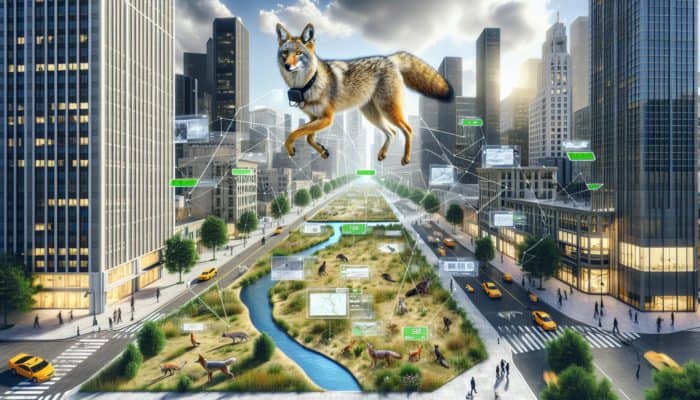Comprehending Urban Predators: An Essential Guide
What Are Urban Predators and Why Are They Important?

Urban Predator Awareness: Urban predators refer to species that have successfully adapted to live in metropolitan areas, creating potential challenges for both human safety and local wildlife. These fascinating creatures can often be spotted in parks, residential neighbourhoods, and even in urban gardens. Their presence introduces a complex interplay between humans and wildlife, making it imperative to gain a profound understanding of their behaviours and ecology. Common examples of urban predators include:
- Raccoons
- Coyotes
- Foxes
- Opossums
- Skunks
- Domestic cats
- Birds of prey (e.g., hawks, owls)
- In some urban areas, alligators
Each of these species exhibits distinct behaviours and adaptations that enable them to survive and flourish in urban habitats, often resulting in increased encounters with humans. Understanding these dynamics is crucial for fostering a harmonious coexistence between urban wildlife and residents.
What Are the Behavioural Patterns and Habits of Urban Predators?
To navigate urban living effectively while coexisting with predators, it is essential to comprehend their daily routines and territorial behaviours. Urban predators typically exhibit heightened activity during twilight hours, which can lead to more frequent interactions with humans. Observing specific behaviours can assist in predicting their movements. Key behaviours to monitor include:
- Foraging during early mornings or late evenings
- Marking territory through scent marking
- Creating dens in concealed areas such as garages or beneath decks
- Demonstrating boldness in human environments, especially when food is accessible
By understanding these patterns, residents can adjust their habits and surroundings to mitigate the likelihood of unwanted encounters with these fascinating creatures.
Why Do Urban Predators Choose to Enter Urban Areas?
Urban environments provide a diverse range of opportunities for many predator species. The abundance of food sources, such as discarded rubbish, pet food, and small mammals, draws these animals into city landscapes. Additionally, urban structures provide shelter from harsh weather conditions, making cities attractive refuges. Furthermore, the disruption of natural habitats due to urban expansion often forces wildlife to seek refuge in urban areas. This influx is typically driven by factors such as:
- Increased food availability, including rodents and leftover human food
- Reduction of natural habitats caused by human development
- Less competition from other predators
- Favourable microclimates within city environments
These elements highlight the increasing visibility of urban predators and their integration into urban life, emphasizing the need for informed management strategies.
How to Foster Coexistence with Urban Predators

Living alongside urban predators need not be a source of concern; instead, it can be an opportunity for peaceful coexistence. Implementing strategic approaches can significantly reduce conflicts and enhance safety. Some effective methods include:
- Securing waste bins with tightly fitting lids
- Bringing pet food indoors during the night
- Eliminating hiding places by trimming bushes and clearing debris
- Installing motion-activated lights to deter nocturnal animals
By making these simple adjustments in daily routines, residents can cultivate an environment where both humans and urban predators can thrive without unwarranted conflict.
What Is the Ecological Impact of Urban Predators?
Urban predators play a multifaceted role within local ecosystems, impacting both wildlife populations and community dynamics. Their presence can yield positive outcomes, such as regulating rodent populations and helping to maintain equilibrium within the food web. However, they may also negatively affect local wildlife, particularly smaller species that may fall prey. The interactions between urban predators and their habitats encompass:
- The reduction of overpopulated species, which can foster healthier ecosystems
- Possible competition with native species, disrupting local biodiversity
- Influencing urban flora and fauna through predation
- Creating potential pathways for disease transmission among wildlife
Understanding these dynamics is vital for devising effective management strategies that benefit both urban wildlife and human communities.
Insights from Experts on Urban Predator Awareness
How Do Experts Monitor Urban Predator Populations?

Experts utilise a diverse array of advanced techniques to monitor urban predator populations, merging technology with field observations for comprehensive data collection. This may involve the deployment of GPS collars, camera traps, and community reporting systems. For instance, GPS collars enable the real-time tracking of movement patterns, providing valuable insights into how these animals navigate the urban landscape. Additionally, camera traps can capture images of predators in action, aiding in the assessment of their population density and behaviours. These methodologies foster a holistic understanding of urban predator dynamics, informing management strategies that encourage coexistence.
What Are the Optimal Practices for Managing Urban Predators?
Effective management of urban predators necessitates a collaborative approach that involves local communities, wildlife specialists, and policymakers. Best practices encompass:
- Creating public awareness campaigns about urban predators
- Implementing community-based monitoring programmes
- Establishing guidelines for safely securing rubbish and pet food
- Encouraging community clean-up efforts to minimise food sources
Each of these steps promotes cooperation and proactive measures that can lead to successful management, ultimately enhancing safety for residents and sustainability for urban wildlife.
How Can Communities Leverage Expert Knowledge for Safety?
Utilizing expert insights can significantly enhance community safety and minimize conflicts with urban predators. By fostering relationships with wildlife experts, communities can access tailored advice on addressing local wildlife issues. Educational workshops empower residents with knowledge about urban predators, enhancing their understanding of behaviours and needs. Such collaborations can yield:
- Increased community awareness regarding safety practices
- Improved local policies grounded in scientific research
- Dedicated resources for urban wildlife management
- Strengthened community bonds through shared goals
By harnessing expert knowledge, communities can work towards creating safer urban environments while recognising the vital role of predators in local ecosystems.
How Can Urban Residents Effectively Coexist with Predators?
Urban residents can adopt specific behaviours to minimise the risks associated with urban predators. Safety begins with awareness and practical strategies that encourage peaceful coexistence. Expert-recommended tactics include:
- Maintaining a safe distance from urban predators if encountered
- Using noise deterrents, such as clapping or shouting, when encountering a predator
- Educating oneself and family about predator behaviours
- Collaborating with neighbours to implement community safety measures
Adopting these practices not only enhances personal safety but also fosters a community culture of coexistence that benefits both humans and wildlife.
Preventing Encounters with Urban Predators
How Can You Fortify Your Home Against Urban Predators?
Securing your home against urban predators is crucial to preventing unwanted encounters. Simple, proactive measures can significantly deter these animals. Effective home security tips include:
- Fencing your yard with a solid barrier that stands at least six feet tall
- Using locks on gates to prevent unauthorised access
- Installing motion-activated lights around the property
- Keeping outdoor grills and patios clean and free of food residues
By implementing these steps, homeowners can create an environment that minimises the likelihood of attracting urban predators, ensuring a safer living space for all residents.
What Should You Do in the Event of a Predator Encounter?
Knowing how to respond during a predator encounter can significantly impact safety. If you find yourself face-to-face with an urban predator, it is essential to remain calm and adhere to these guidelines:
- Do not run; this may trigger a chase instinct.
- Make yourself appear larger by raising your arms.
- Make loud noises to scare the animal away.
- Back away slowly, keeping an eye on the predator without turning your back.
Understanding these responses can help prevent dangerous situations while fostering respectful interactions with urban wildlife.
Why Are Community Education Programmes Important?
Community education plays a pivotal role in alleviating fear and enhancing safety concerning urban predators. By informing residents about the behaviours and needs of these animals, communities can cultivate a more positive perspective on urban wildlife. Educational programmes may encompass:
- Workshops on urban predator identification and behaviours
- Information sessions on securing properties
- Community forums to discuss concerns and share experiences
- Engagement activities, such as nature walks to observe urban wildlife
These initiatives not only educate residents but also promote a culture of coexistence, ultimately enhancing overall community safety.
Recognising Signs of Urban Predator Activity
How to Identify Predator Tracks and Scat
Recognising signs of predator activity is crucial for early detection and effective management. Understanding how to identify tracks and scat can provide valuable insights into the types of predators inhabiting your area. Each species leaves distinct tracks; for instance, a coyote track is generally larger than that of a domestic dog and features a more defined shape. Scat also varies between species; raccoon scat, for example, often contains remnants of fruit and other foods they have consumed. Common signs to look for include:
- Footprints in soft soil or snow
- Scat with identifiable contents
- Scratches on trees or fences that indicate territory marking
- Hair caught on fences or shrubs
By familiarising yourself with these signs, you can better monitor local predator activities and adapt your safety strategies accordingly.
What Does Damage from Predators Look Like?
Urban predators can inflict various types of damage, ranging from property destruction to predation of pets or livestock. Recognising these signs can help in addressing potential issues promptly. Indicators of predator activity on your property may include:
- Disturbed rubbish or bird feeders
- Scratches on doors or fences
- Missing livestock or pets
- Signs of digging or denning beneath structures
Being vigilant and understanding these signs can empower homeowners to take appropriate actions to mitigate risks associated with urban predators.
How to Report Sightings of Urban Predators
Reporting urban predator sightings is vital for effectively tracking and managing predator populations. Residents are encouraged to document their observations and communicate them to local wildlife authorities. Steps to report sightings include:
- Noting the time, location, and description of the animal.
- Taking photographs if it is safe to do so.
- Contacting local wildlife agencies or using community reporting apps.
- Sharing your information with neighbours to raise awareness.
This proactive approach can help authorities monitor urban predator populations, leading to more effective management strategies and enhanced safety for residents.
Strategies for Coexisting with Urban Predators
What Strategies Promote Safe Coexistence?
Successfully coexisting with urban predators necessitates a blend of comprehension and adaptability. Implementing thoughtful strategies can mitigate risks and nurture a harmonious relationship. Key strategies include:
- Developing community guidelines for wildlife interactions
- Encouraging responsible pet ownership, such as keeping pets indoors at night
- Creating green spaces that support biodiversity, maintaining a natural balance
- Facilitating community discussions on best practices for safety
By embracing these strategies, communities can cultivate environments where both humans and urban predators can thrive harmoniously.
What Are the Advantages of Coexistence with Urban Predators?
The benefits of coexisting with urban predators extend well beyond mere tolerance. Embracing these creatures enriches biodiversity and promotes ecological health. The positive impacts include:
- Natural pest control through the predation of rodents and insects
- Enhanced public interest in wildlife conservation
- Increased awareness of urban ecosystems and their complexities
- Opportunities for educational programmes that foster empathy towards wildlife
These factors underscore the importance of recognising urban predators as essential components of urban ecosystems rather than mere threats to human safety.
What Community Initiatives Foster Coexistence?
Community-led initiatives are crucial for fostering a harmonious environment alongside urban predators. Successful programmes often focus on education, collaboration, and proactive management strategies. Effective initiatives include:
- Neighborhood watch programmes dedicated to monitoring urban wildlife
- School partnerships with wildlife organisations for educational outreach
- Community clean-up events to reduce attractants
- Workshops on safe interactions with local wildlife
Through these efforts, communities can promote coexistence while ensuring safety and enhancing their understanding of urban wildlife.
How Can Public Education Enhance Understanding of Urban Predators?
Education serves as a powerful tool in increasing public awareness and safety concerning urban predators. Effective methods for educating communities about these animals encompass:
- Hosting informational sessions led by wildlife experts
- Creating educational materials, such as brochures and online resources
- Utilising social media platforms to share tips and information
- Encouraging local schools to integrate wildlife education into curricula
These strategies empower residents to make informed decisions, leading to safer communities and a more profound respect for urban wildlife.
What Policies Support Effective Urban Predator Management?
Robust policies and legislation play a crucial role in managing urban predators. Local governments must develop frameworks that strike a balance between safety and conservation efforts. Key areas of focus include:
- Implementing regulations for responsible pet ownership
- Establishing guidelines for wildlife feeding and attractants
- Enhancing funding for urban wildlife management programmes
- Promoting community involvement in policy development
These measures can create a sustainable approach to urban predator management that benefits both residents and wildlife, ensuring a harmonious coexistence.
Research-Backed Benefits of Urban Predator Awareness
How Does Increased Awareness Mitigate Conflicts?
Awareness programmes are instrumental in reducing conflicts between humans and urban predators. By educating communities about predator behaviour, safety practices, and coexistence strategies, the incidence of fear and misunderstanding diminishes. Research indicates that communities with robust awareness initiatives experience:
- Fewer wildlife-related incidents and complaints
- Increased willingness among residents to adopt safety measures
- Greater cooperation between community members in monitoring wildlife
- Enhanced appreciation for the role of predators in urban ecosystems
These benefits underscore the importance of ongoing education and community engagement in promoting coexistence and understanding.
What Impact Does Public Awareness Have on Biodiversity?
Awareness initiatives can significantly support biodiversity by promoting responsible behaviours and coexistence strategies among urban residents. When communities comprehend the importance of predators in maintaining ecological balance, they are more likely to:
- Support conservation efforts aimed at protecting urban wildlife habitats
- Participate in citizen science programmes that monitor local biodiversity
- Advocate for policies that ensure safe coexistence with urban predators
- Foster a culture of respect towards all wildlife
These factors contribute to healthier ecosystems and a richer urban biodiversity, illustrating the essential role of education in urban wildlife management.
What Is the Influence of Public Policy on Predator Awareness?
Public policy has a significant impact on enhancing urban predator awareness and management. Strong policies can facilitate educational programmes and community initiatives aimed at promoting coexistence. Areas where public policy can substantially affect include:
- Funding for research on urban wildlife dynamics
- Incentives for community-based wildlife management programmes
- Regulations on wildlife feeding and attractants
- Support for habitat preservation and restoration projects
By prioritising these elements, policymakers can ensure that urban predator awareness is integrated into community planning and development, fostering safer urban environments for all residents.
Teaching Children About Urban Predators
What Knowledge Should Children Acquire About Urban Predators?
Educating children about urban predators is essential for ensuring their safety and fostering respect for wildlife. Children should grasp fundamental facts about these animals, including their behaviours, habitats, and the significance of maintaining a safe distance. Key topics to cover include:
- The types of urban predators they might encounter
- How to recognise signs of predator activity
- Safe practices when encountering a predator
- The ecological role of predators in the ecosystem
By imparting this knowledge, children can develop a healthy understanding of urban wildlife and the importance of coexistence, ultimately preparing them for interactions with these fascinating creatures.
What Role Do School Programs and Workshops Play?
Educational programmes in schools play a pivotal role in teaching children about urban predators. Implementing interactive workshops and curriculum-based lessons can effectively engage students. Successful elements of these programmes include:
- Hands-on activities, such as tracking and identifying local wildlife
- Guest lectures from wildlife experts to provide real-world insights
- Field trips to local parks to observe urban ecosystems
- Creative projects that allow children to express their learning
These initiatives not only educate children but also encourage them to become advocates for wildlife conservation within their communities, fostering a sense of responsibility toward their environment.
How Can Parents Reinforce Predator Safety Lessons at Home?
Parents hold a crucial role in reinforcing predator safety lessons learned in school. By engaging in discussions and activities related to urban predators, parents can deepen their children's understanding. Effective strategies include:
- Encouraging children to share what they have learned in school about wildlife
- Setting up family outings in nature to observe wildlife responsibly
- Creating a safe space for open discussions about fears and experiences with urban predators
- Modelling responsible behaviours regarding interactions with wildlife
By actively participating in these educational efforts, parents can help cultivate a sense of stewardship in their children towards urban wildlife, ensuring they grow up with a profound respect for nature.
What Are Effective Community Outreach and Public Awareness Campaigns?
Community outreach initiatives can significantly enrich children’s understanding of urban predators. Effective campaigns may include:
- Family-friendly events featuring wildlife education booths
- Collaborative projects between schools and local wildlife organisations
- Interactive programmes that promote safe interactions with wildlife
- Social media campaigns that disseminate educational content and practical tips
These efforts not only educate children but also foster a collective community understanding of how to coexist safely with urban predators, promoting a culture of respect for wildlife among all age groups.
What Interactive Learning Tools and Resources Are Available?
Engaging learning tools can effectively enhance children’s understanding of urban predators. Interactive resources, such as apps, games, and educational websites, can provide immersive experiences. Useful tools include:
- Mobile apps for tracking and identifying local wildlife
- Online games that teach about ecosystems and predator-prey relationships
- Interactive educational videos highlighting urban wildlife
- Resource websites offering printable materials for children
These tools can make learning about urban predators enjoyable and engaging, encouraging children to explore and appreciate their local environments while fostering a sense of curiosity about the natural world.
Debunking Urban Predator Myths and Facts
What Are the Common Myths Surrounding Urban Predators?
Misinformation surrounding urban predators can lead to unnecessary fear and ineffective management. Debunking common myths is essential for cultivating a more informed community. Some prevalent myths include:
- All urban predators are dangerous to humans.
- Urban predators will attack pets if allowed outside.
- Predators such as coyotes are overly aggressive in urban settings.
- Feeding urban wildlife is beneficial for their survival.
By clarifying these misconceptions, communities can develop a more balanced understanding of urban wildlife behaviour, reducing unwarranted fears and fostering coexistence.
What Are the Real Risks Associated with Urban Predators?
Understanding the actual risks posed by urban predators is crucial for developing appropriate responses. While encounters can be alarming, the reality is that most urban predators prefer to avoid humans. Real risks include:
- Potential for minor conflicts with pets if left unattended
- Occasional property damage, such as digging in gardens
- Transmission of diseases among wildlife populations
- Human-wildlife interactions that lead to fear and misunderstanding
Recognising these risks enables communities to implement effective safety measures while respecting urban wildlife and acknowledging their role within the ecosystem.
How Can You Differentiate Fact from Fiction Regarding Urban Predators?
Learning to separate myths from facts is essential for effective predator awareness. Residents can evaluate predator-related information by:
- Consulting local wildlife agencies for accurate data
- Participating in community workshops led by experts
- Engaging with reputable wildlife organisations and their resources
- Encouraging open discussions within the community about wildlife issues
By fostering critical thinking and informed discussions, communities can cultivate a more accurate understanding of urban predators, enhancing coexistence and wildlife management strategies.
Proven Strategies for Urban Predator Awareness
How Can Technology Enhance Predator Awareness?
Technology plays a crucial role in monitoring and managing urban predator populations. Various tools and applications offer innovative solutions for both experts and residents. Examples include:
- Mobile apps that enable users to report sightings and share information
- Camera traps that capture nocturnal activities for research and monitoring
- GIS mapping systems to track predator movements and hotspots
- Social media platforms for community engagement and awareness campaigns
These technological advancements significantly enhance predator awareness efforts, facilitating more effective management strategies and fostering a safer coexistence between urban wildlife and residents.
What Community-Based Approaches Are Effective for Predator Awareness?
Community involvement is essential to the success of urban predator awareness programmes. Effective community-based strategies include:
- Establishing partnerships between residents and local wildlife experts
- Creating volunteer programmes for monitoring wildlife activity
- Hosting neighbourhood meetings for sharing experiences and strategies
- Collaborating with schools to integrate predator education into curricula
By actively engaging the community, awareness initiatives can foster a culture of coexistence and safety, thereby enhancing the overall well-being of both urban wildlife and human residents.
What Role Do Wildlife Organizations Play in Promoting Awareness?
Wildlife organisations are instrumental in educating the public about urban predators. Their contributions include:
- Providing expert knowledge and resources for community education
- Researching urban wildlife dynamics and management strategies
- Leading outreach programmes that connect residents with local wildlife
- Advocating for policies that support predator conservation and management
These efforts help bridge the gap between communities and wildlife, promoting safer interactions while deepening understanding of urban ecosystems and their complexities.
FAQs on Urban Predators
What Are the Most Common Urban Predators Found in Cities?
The most common urban predators include raccoons, coyotes, foxes, opossums, skunks, and various birds of prey, each uniquely adapted to thrive in city environments.
How Can I Identify If an Urban Predator Is Present in My Area?
Signs of urban predator activity include tracks, scat, disturbed garbage, and sightings of the animals themselves, particularly during twilight hours.
What Steps Should I Take If I Encounter a Predator?
Remain calm, avoid running, make yourself appear larger, and back away slowly while making noise to encourage the predator to leave the area.
Are Urban Predators a Threat to Pets?
While urban predators generally avoid human interactions, they may pose a risk to unattended pets. It is advisable to keep pets secured indoors at night.
How Can I Promote Safe Coexistence with Urban Predators?
Securing your rubbish, removing attractants, and educating yourself about local wildlife behaviours can facilitate peaceful coexistence with urban predators.
What Educational Resources Are Available to Learn About Urban Predators?
Many local wildlife organisations offer workshops, educational materials, and online resources designed to educate residents about urban predators and their behaviours.
How Can I Report a Sighting of an Urban Predator?
To report sightings, contact local wildlife agencies, documenting details such as time, location, and any identifiable characteristics of the animal observed.
Are Urban Predators Beneficial to City Ecosystems?
Yes, urban predators play a crucial role in controlling populations of rodents and other small animals, thereby maintaining a balanced urban ecosystem.
What Myths Are Commonly Associated with Urban Predators?
Common myths include the belief that all urban predators are aggressive or that feeding them aids in their survival, both of which can lead to misunderstandings and mismanagement.
How Can Technology Assist in Managing Urban Predator Populations?
Technology aids monitoring through GPS tracking, camera traps, and community reporting apps, enhancing awareness and management strategies for urban wildlife.
Explore more with us on X!
Water Collection Systems: Essential Solutions for Sustainability
Comprehensive Overview of Water Collection Systems What Exactly Are Water Collection Systems? Water Collection Systems: Water collection systems encompass a variety of innovative technologies and methodologies specifically developed to capture, store, and utilise water from diverse sources, with a primary focus on rainwater. These systems are crucial for the sustainable management of water resources, particularly in […]
Portable Water Filters: Essential for Clean Drinking
Comprehensive Guide to Portable Water Filters What Exactly Are Portable Water Filters? Portable Water Filters: Portable water filters are compact and efficient devices engineered to purify water from various sources, ensuring it is safe for consumption. These filters are essential tools for outdoor enthusiasts, travellers, and individuals preparing for emergencies. They provide access to clean […]
Urban Gardening Survival: Thrive in Cities
Key Strategies for Successful Urban Gardening Mastering Soil Management in Urban Settings Urban Gardening Survival: Effectively maintaining healthy soil is paramount for achieving success in any urban garden, particularly when space is limited. Urban settings often present distinct challenges, including compacted soil and a scarcity of organic matter. Gaining a comprehensive understanding of how to […]
Off-Grid Power Solutions: Universal Energy Access
Comprehensive Overview of Off-Grid Power Solutions What Are Off-Grid Power Solutions and Their Importance? Off-Grid Power Solutions: Off-grid power solutions are self-sufficient energy systems that generate electricity independently of the central power grid. These systems are crucial for supplying energy to remote or isolated areas where traditional electrical infrastructure is either impractical or nonexistent. By harnessing […]







